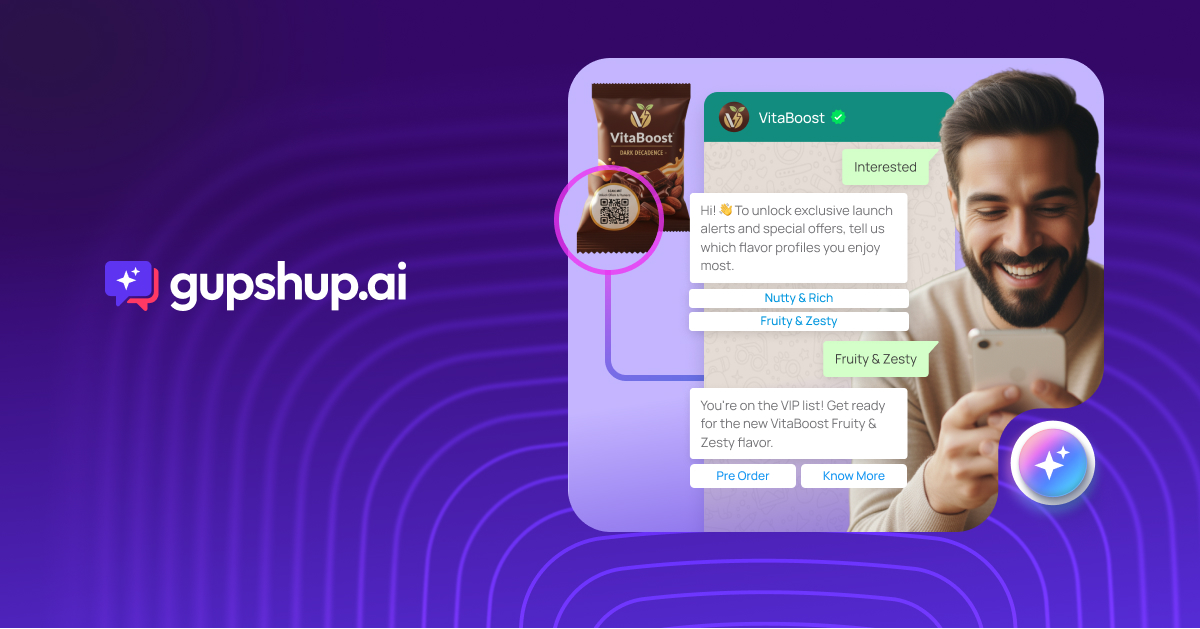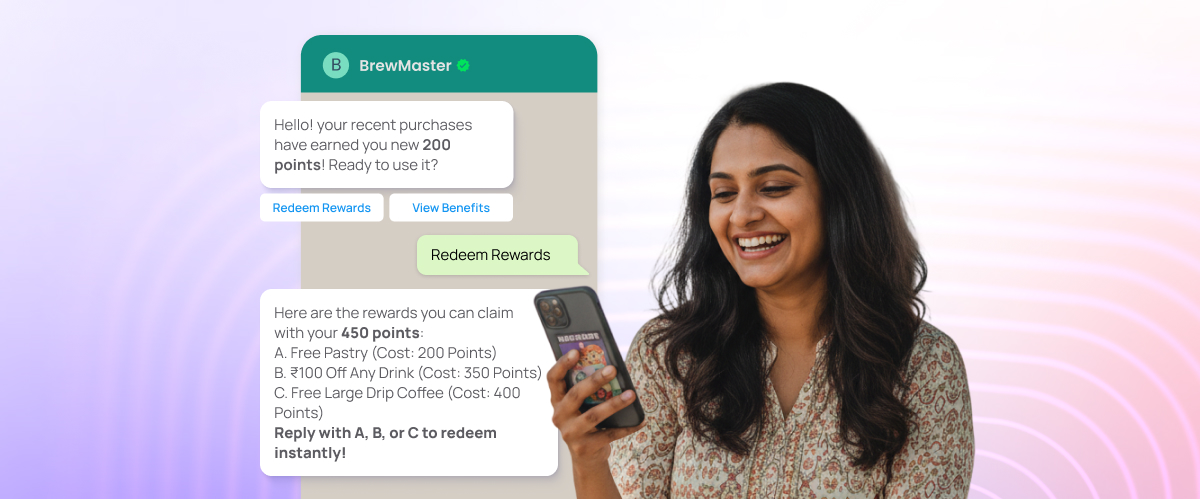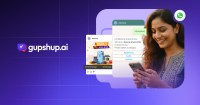5 Use Cases to Prove Conversational AI is Transforming CPG Advertising

- Introduction
- Use Case 1: Activating Paid Media Through Conversational Entry Points
- Use Case 2: Dynamic Personalization Across Brand and Region Portfolios
- Use Case 3: Real-Time Campaign Performance Optimisation
- Use Case 4: Loyalty and Retention Without Apps
- Use Case 5: Unified Demand Signals Across Consumers and Retailers
- Conclusion
- FAQ
See the power of intelligent conversations for your brand.
Introduction
CPG advertising used to be all about big billboards, catchy jingles, and taglines you’d hear on a loop until they haunted your dreams. That playbook worked when mass reach was the only goal.
But now? Your consumers want to debate which cereal is the ultimate midnight snack champion. They want your energy drink brand to coach them through their next 5 a.m. workout. They want your skincare line to send them pep talks on bad skin days.
And guess what? They can.
Conversational AI can help you with that. It is your new MVP that’s turning one-way campaigns into millions of two-way conversations. It slides into DMs, sparks real-time banter, delivers instant samples, and turns impulse buys into lifelong loyalty badges. It’s the difference between “seen” and “saved,” between being skipped and being screenshotted.
And if you’re still debating it, you must understand that your competitors are already ten replies ahead.
Let’s understand the five use cases of Conversational AI that prove it is giving advertising a whole new personality.
Use Case 1: Activating Paid Media Through Conversational Entry Points
CPG marketers pour millions into above-the-line and below-the-line (ATL/BTL) campaigns but often own almost no consumer data. They may reach millions with TVCs and billboards, yet virtually none directly opt-in, leaving brands blind to who their buyers really are and what they actually want.
How Conversational AI fixes that
Conversational AI transforms every brand touchpoint into an active data collection channel:
- QR codes on packaging: Dynamic QR codes turn scan events into first-party data moments. Platforms like Gupshup enable brands to capture consumer preferences, demographics, and behaviors directly from product packaging scans. In fact, 75% of online grocery shoppers scan QR codes in-store.
- Media CTAs: Rather than directing users to static landing pages, ads can invite them into WhatsApp or Instagram DMs, triggering real-time conversations and data capture.
- Messaging platforms: AI-powered chatbots on WhatsApp, Messenger, and Instagram collect consent, profile info, purchase intent, and sentiment, all while steering personalized engagement.
What companies should do –
- Build high-quality, first-party databases.
QR-enabled packaging captures real-time analytics, scans, views, and clicks without third-party cookies.
- Retarget without cookies.
Conversational AI allows direct follow-ups. If someone starts a chat after scanning a QR code, you can retarget them using WhatsApp or on-site chat without relying on third-party tracking. - Shift from static surveys to dynamic insights.
Live conversational data beats stale post-campaign surveys. Chatbots using open-ended questions (e.g., “What flavors do you love?”) deliver richer insights and higher engagement, even outperforming traditional surveys in informativeness.
Leading CPG tech platforms (like Gupshup) offer unified messaging via AI chatbots that sync with CRM and e-commerce systems, turning every interaction into a data-driven play.
Use Case 2: Dynamic Personalization Across Brand and Region Portfolios
A typical CPG company may juggle 100+ SKUs across 15+ languages and regions, making truly personalized marketing overwhelming. Consumers expect tailored messages. But customizing campaigns manually for every segment is costly, time-consuming, and nearly impossible at scale.
How Conversational AI solves it
Gupshup’s AI Agents automatically adapt customer journeys based on:
- Entry point (e.g., QR scan vs. “Click to WhatsApp” ad)
- Region & language (supporting 15+ languages like Hindi, Kannada, and Arabic)
- Product category & SKU (from spices to skincare)
These agents auto-adjust flows for region, language, and SKU, allowing one campaign setup to dynamically personalize itself into hundreds of localized experiences.
How it works:
- Built on Gupshup Conversation Cloud, these agents combine LLM-powered understanding with backend data (e.g., CRM, inventory, catalog) to craft personalized, context-aware responses.
- They manage inbound and outbound flows, proactively sending restock alerts or festival-specific offers while responding to user inputs intelligently.
- Pre-built for CPG/FMCG, these agents can handle product discovery, order tracking, and loyalty engagement, all in multiple languages.
What marketing heads care about
| Priority | Benefit via Conversational AI |
| Minimize the cost of personalization | One pipeline adapts dynamically. No need for separate versions. Saves Dev/Creative resources. |
| Improve AOV via relevance | AI can recommend high-margin SKUs (e.g., a skincare bundle vs. a single-item sale), thereby boosting the average order value. |
| Run agile, localized campaigns | Shift instantly based on cultural moments, send Diwali messages in Gujarati, Ramadan recipes in Arabic, or festival bundles in Spanish-speaking regions. |
Data-backed validation –
- Multilingual support
Gupshup’s agents already operate in 15+ languages, including regional Indian and MENA languages. - CPG-specific use cases
FMCG brands use Gupshup for recipe recommendations, personalized product discovery, and localized promotions across regions. - Scale and reach
Supporting 45,000+ brands in 60+ countries and processing 120 billion messages annually, Gupshup proves it can handle massive, global scale.
Behind the scenes with LLMs + backend sync
Seamless integrations enable AI Agents to recall past chats, regional preferences, and SKU-level data, which is crucial for real-time personalization.
Use Case 3: Real-Time Campaign Performance Optimisation
Most marketers only see what worked after the campaign wraps up, by which time the budget is gone and it’s too late to pivot.
How Conversational AI makes campaigns smarter
- Every message is a micro-test – Each conversational prompt acts like a mini A/B experiment.
- Adaptive flows in real-time – AI can adjust scripts based on live performance metrics: drop-off points, response rates, link clicks.
- Live analytics mid-flight – You’re no longer waiting for post-campaign reports; dashboards show engagement and conversions as they happen.
What companies should do –
- Run agile campaigns with real-time reporting.
Conversational platforms like Gupshup provide live dashboards that show message delivery, engagement, and completion rates, allowing for immediate adjustments. - Improve media ROI without increasing budget.
According to Smartly, AI-enabled budget reallocation based on performance can boost conversion by 10% and reduce CPA/CPC.
Use behavior as conversion signals.
Rather than waiting for users to check out, platforms can treat message opens, replies, or link taps as valid conversion signals, triggering follow-up sequences, retargeting, or upsells instantly.
Use Case 4: Loyalty and Retention Without Apps

CPG brands often suffer from weak consumer connections, retailers own the shelf, the sale, and the data. That’s why loyalty apps flop and programs stagnate. Brands get relegated to the background, seen only at checkout lines and on shelf labels.
How Conversational AI saves the day
Gupshup’s AI Agents bring loyalty programs directly into WhatsApp, no app downloads, no new accounts:
- Receipt OCR: Customers snap a photo of any ticket, be it a receipt or an invoice, and the bot instantly credits points.
- Cashback journeys: A message triggers cashback eligibility with no external redirects.
- Gamified rewards: Quizzes, spin-the-wheel mechanics, and challenge prompts make earning feel like fun.
- Real-time balance & redemption: Users can check points, tier status, or redeem rewards, right inside chat, without installing anything.
From reward redemption to point tracking, everything happens natively inside WhatsApp, with no app installs, login fatigue, or manual claim forms.
Why Marketing Heads Nod Yes
| Priority | Conversational AI Benefit |
| Increase repeat purchases | Instant reward confirmation boosts the frequency of purchase behaviors. |
| Build brand affinity | Personalized, chat-based interaction feels intimate and relevant. |
| Lower CAC by boosting LTV | Chat-based loyalty reduces acquisition costs while growing retention. |
Real-world proof –
- Receipt OCR in Latin America
CPG brands in LATAM using WhatsApp chatbots let customers upload receipts directly in chat. The result: smooth loyalty redemption with zero fraud risk, replacing sticker books and punch cards. - WhatsApp loyalty adoption
WhatsApp-based loyalty programs tripled repeat customers and boosted lifetime value by 98%, thanks to near-98% open rates and automation. - High ROI through WhatsApp
Gupshup’s Conversation Cloud + WhatsApp delivered 50% more engagement than SMS/email campaigns, culminating in 270% ROI over three years and improved retention metrics.
First-party data advantage
WhatsApp end-to-end commerce doesn’t just retain, it gives brands back their data. Receipt uploads, opt-ins, and interactions feed into a robust first-party dataset for re-engagement
Use Case 5: Unified Demand Signals Across Consumers and Retailers
Marketing, trade, and supply teams often operate in silos, leading to painful blindspots. Consumer demand spikes only become visible once shelves run empty, or sales tanks because inventory never reaches stores.
How Conversational AI bridges the gap –
Gupshup’s AI Agents support both B2C (consumer-facing) and B2B (retailer-facing) workflows, tapping into both sides of the value chain through one unified intelligence layer:
- Consumer channels: Chatbots on WhatsApp, Instagram, or web chat trigger conversations, collecting spikes in interest and capturing flavor/demand shifts live.
- Retailer/distributor channels: Parallel journeys let stores place orders, report low stock, or confirm delivery times via the same conversational engine.
- Unified insights: All interactions feed into a single dashboard. So, pre-Diwali detergent runs or mid-season snack cravings aren’t discovered too late.
What companies should do –
- Anticipate regional spikes
Agents field real-time queries like “Is the new diya soap back in Pune stores?” which become early-warning signals, enabling proactive stock boosts before demand outpaces supply. - Align media & inventory
If WhatsApp bots report high interest in mango-flavored beverages in Tamil Nadu, and distributor messages show low stock, marketers can shift ad spend there, or push alternate SKUs dynamically.
Act on retailer feedback instantly
A store can message “Only red rice flour left—restock?” and bots trigger targeted campaigns: “Grab 2 kg at 10% off this week”, syncing promotions with supply realities.
Conclusion
Conversational AI has moved far beyond simple chatbots. For CPG brands, it is now a powerful channel to collect first-party data, personalize experiences at scale, optimize campaigns in real-time, build loyalty without app fatigue, and unify demand signals across consumers and retailers.
Gupshup’s AI Agents help brands run agile, data-driven campaigns that adapt to regions, languages, and categories. They enable marketers to engage directly with consumers, boost repeat purchases, push high-margin SKUs, and align marketing with supply in ways traditional channels cannot achieve.
The future of CPG advertising is not about one-way messaging. It is about continuous, intelligent, and personalized conversations that drive growth.
FAQ
Which is a use case for conversational AI?
Conversational AI is used in conversational commerce, where brands like Walmart or Sephora engage consumers via chatbots to provide personalized recommendations and real-time assistance, turning sales into interactive experiences.
What is the use case of AI in marketing?
AI in marketing enables dynamic personalization, campaign optimization, and customer support, such as optimizing ad performance, powering chatbots for 24/7 engagement, and delivering tailored product suggestions.
What is AI chatbots used for?
AI chatbots are used for customer support, lead qualification, automating repetitive queries, upselling/cross‑selling, and collecting user data, all via natural-language interactions on web or messaging platforms.



 +91-9355000192
+91-9355000192 Login
Login





